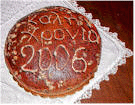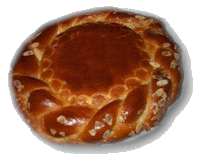THE CUSTOM OF THE CUTTING OF VASILOPITA(New Year Bread-pie-Cake)
Written by Athina Tzinikou- Kakouli, Philologist, Folklorist Especially for the cutting of the e-Vasilopita in Internet.
None of the annual customs is continued so infrangibly by the Greeks (all over the world), and has not so deep roots through the years, as the New Year’s Cake. Because always, the hidden coin (flouri) represents the fluke of luck, which shows the fortunate of the New Year.
Truly, Greeks, as members of a family, a fellowship or a society of
organized people, do not celebrate the coming of the New Year without the cutting of the Vasilopita.
If nowadays in many occasions, we have geared the vasilopita according to the bourgeois habits and facts of a consumer society, and if we have transformed it into a big, sweet, de luxe cake (and the solution is a confectionery), there are still Greek housewives, who insist on making the vasilopita using the traditional way. A traditional recipe which is thought from mother to daughter continues through the years.
In the collective conscience of our nation, the vasilopita, sweet or salty, with sugar or meat, refers to a new year’s symbol with great attributes, not only revelational, but also determinative for the luck of the people, the animals and the possessions of the Greek family. Cause then, even the way of making it, would also assure the good year. Such beliefs can hardly be lifted from the soul of the  nation.
nation.
All the exceptional properties which have been ascribed to the vasilopita conduced so that its preparation turns to a symbolic ritual accompanied by actions of magic.
In Selinio, Chania (Crete), for instance, vasilopita was blended with oil, sugar and spice, symbols of the cornucopia of the family goods. As soon as the housewife had laid the vasilopita into the baking tin, slashed a cross at the top of it, using a fork, intending to exorcize the bad spirits.
Using the same ingredients sugar and spice, people in Kidonies prepared the vasilopita. Furthermore, they used to slash it with strange shapes, using a key, intending to lock the gossips and bad words. They also used a finger shield, symbol of neatness, to fill the blankets with figures, so that the women remain strong and capable.
 Sweet vasilopita was made mainly in urban areas, but also in many agricultural districts of our country. The ingredients used to be the same. There was just a variety through the regions and families, which concerned the way of its decoration, the “letters” as they used to say. Piece of finery made by dough, each of them was corresponding to a wish, a desire or an appetence.
Sweet vasilopita was made mainly in urban areas, but also in many agricultural districts of our country. The ingredients used to be the same. There was just a variety through the regions and families, which concerned the way of its decoration, the “letters” as they used to say. Piece of finery made by dough, each of them was corresponding to a wish, a desire or an appetence.
So, the farmer’s wife was “marking” on the vasilopita the grub hook, the animals, the aristae so that St.Vasilios bless them and give his grace for a rich crop. Equally did shepherd’s wife. She was “marking” the sheepfold, the sheep, the dogs, the churns of milk. The vine grower’s wife was “marking” the billets, the barrel, the winepress and whatever her heart desired, that the kind St. Vasilios should bless.
The traditional vasilopita that was made along the coast of Minor Asia had a remarkable appearance and taste. It looked like a big gristly biscuit, dight with a double headed eagle placed in the middle of it, expressing the intimate desire and wish, for a national resurrection of the Byzantine Empire. In Constantinople, the vasilopita was sweet, fluffy and scented with spice. In the middle of it, a big V was graven, representing the capital letter of St.Vasilios, or the capital letter of the Goodman’s name and around the cake, embroidery was graven using a pair of scissors, that referred to birds with wide open wings.
The most usual traditional New Year’s cake was the salty vasilopita, which was made with many flakes and was filled with meat, and its decoration couldn’t hide the intimate wishes and the deepest symbolism.
Furthermore, there were no margins for finery, cause the top and the bottom of the vasilopita was filled with well- buttered flakes, that in various regions were called “petara”. The external flaky, appreciably bigger, was flapped wavy, so that the cake’s surface would be impressive, anastatic, wavy, expressing the wish for cornucopia of the family’s goods, like the wave of the wide sea.
In the salty vasilopita, the wishes and the symbolisms were mainly expressed by “marks” (except the traditional coin “flouri”) that the housewife would hide at the base of the cake.
So, for example, the tradition in Epirus demanded a vasilopita stuffed with chicken, lamb mince or whole peaces of pork, mixed with frumenty, leek and eggs. Aside from the coin (flouri), there were other “signs” too, according to the job of the family members, such as a little stick for the shepherd, a pine cone for the woodcutter, a straw for the farmer, a cross for the house, or some fruits such as wheat, bean or corn, and whatever people desired.
In west Macedonia and Thrace, when the father of the family had to divide the property to the sons, St. Vasilios used to “take care” of the division. In the big cake, the “signs” weren’t put for the wish but for the “division”. The pieces of the vasilopita were called “kisses”. The son in whose “kiss” was the coin (flouri) hidden, would own the house. The bean corresponded to a field, the vine stick to the vineyard, the straw to the animals e.t.c.
 But also the cutting of the vasilopita was a real ritual. Firstly the father of the family had to rotate the cake three times on the name of trinity. Afterwards he passed a key, a knife or a fork above the cake in the shape of the cross, in order to “stop” the gossip, the bad thoughts and to deter the effects of envy. On the coming of the New Year, he cut the cake into pieces and named each of them, in an established turn.
But also the cutting of the vasilopita was a real ritual. Firstly the father of the family had to rotate the cake three times on the name of trinity. Afterwards he passed a key, a knife or a fork above the cake in the shape of the cross, in order to “stop” the gossip, the bad thoughts and to deter the effects of envy. On the coming of the New Year, he cut the cake into pieces and named each of them, in an established turn.
The first piece destined for St. Vasilios. The second for Christ and Mother, the third for the house, and the rest for the members of the
family starting from the oldest. There was also a piece of cake dedicated to the poor, the animal, the fields and the vineyard, the mill and the boat, because everything had to be blessed by St. Vasilios. As soon as the festive board was finished, the father went to the neat house to feed the animals the piece of cake. He also cut a piece of cake into small pieces and threw them over the fields.
In other regions, such as Karpathos and Skiros, a second vasilopita was blended, dedicated to the big animals (home-maker’s valuable collaborators), called “vouopita” (ox pie), which was given to the animals the first day of the year.
In Chasia, a second cake was made for the sake of
the shepherd. After the family had cut the vasilopita, in the midnight, the men used to cut the shepherd’s vasilopita in the sheepfold, a procedure who turned to a funny revel full of songs, dance and laughter till the morning. In that cake the coin (flouri) had no meaning. Instead of the coin, a little stick was put, called “mantri” (sheepfold), considered to be something holy. The man who would find the stick, had to bury it somewhere in the sheepfold, where no man or animal could step on it.
In Siatista, the tradition included two New Year’s Cakes. A sweet and a salty one. The sweet cake was cut when the year changed so that it would bring sweet days to the family and the salty one that contained the silver coin, the “gift”, was cut at the festive board on the first day of the year. The lucky one who found the hidden coin, had to light a candle for the good of the hole family. That cake also contained a little cross, consisted of unseasoned branches, which brought happiness and health.
The question is where we have to look for the roots of this special custom … the cutting of the New Year’s Cake?
The Greek nation is a carrier and a creator of a marvelous civilization, which is irrigated from the ancient Greek past and Christian Byzantium. That’s why all the customs have an ancient Greek and Christian explanation, which comes not only from ancient Greece, bur also from Christian Byzantium.
According to the Greek tradition, the New Year’s Cake has been established as a custom of the celebration of St. Vasilios, on the first day of the year, because of the following event:
Beforetime, in Kapadokia where St. Vasilios lived in the capacity of abbacy, the land suffered from a death famine and the people suffered from malnutrition. But that didn’t seem to be a problem for the tough eparch Elbinios, who was demanding to get the taxes in any way, even by threatening the people with raid and sack of Caesarea. Then St. Vasilios appealed to each one of the citizens to offer a piece of jeweler, preparative to entice the eparch, and save their home and lives.
A whole treasure had been gathered indeed!
Thereafter, St. Vasilios met the tough eparch and using his suave manners, narrated the tragedy of his people. He also mentioned that the law-abiding citizens were willing to pay the taxes even doing without their heirloom and precious jeweler. St. Vasilios, smoothed up with palaver the soul of the eparch and abated his anger, so that the eparch remitted the taxes, and gave back the treasure.
But what would anyone own? How could St. Vasilios give back that entire jewel? The idea that he had, could give the solution. He gave to each family a cake, in which a jewel was hidden. The rest was God’s business. Since then, the New Year’s Cake has been established as a custom, that indicates the lucky one of the year.
On the other side, the folklorists are still searching the ancient Greek roots of the custom. Cause as we know, in the past, people around the world after learning the way of making flour, needed to dedicate small pieces of bred (as an offer) to the spirits of nature.
That’s why the folklorists detect the roots of the custom of vasilopita, through the “festive bread” that ancient Greeks, offered to the Gods, during every big moment of their lives. For example, every Athenian soldier had to dedicate to Ares, the god of war, three pieces of bread, before he lived for the war. The first one was a wish to win in the battle. The second one was a wish to come back home and the third one was a wish, to come back healthy and able in body and mind. These breads were also given, as an offer, to Artemis the goddess of hunting, to Dimetra the goddess of earth and nature.
The Romans adopted the habits of Greeks, and they started making their own pie, as an offer to Saturn, the god of fertility. They were the first to establish the coin in the pie, as a sign of health and luck. They also used to put a little piece of papyrus in the cake, which could give the freedom to the slave who would find it.
Folklorists also say that the best pies were made by the habitants of Byzantium, who blended the pie, using yeast, eggs, grease and sugar. The decoration consisted of a dough cross, and the monograms of Christ and Mother.
So vasilopita, became the most characteristic custom of the new Year’s day for the Greeks, starting as an ancient habit (offer to the gods), afterwards as a habit of the Romans, and at the end as a
Christian habit in the Byzantium, which was conjunct to St. Vasilios whose memory is celebrated on the first day of the New Year.
 Here are some new elements, sent by friends of the Vasilopita:
Here are some new elements, sent by friends of the Vasilopita:
In Thrace, people used to put a cross made of two sticks or toothpicks in the cake. Families who owned buffaloes, (black animals such as cows), used to put in the vasilopita a piece of charcoal.
All these signs weren’t put in the cake, but at the base of it.
===============================================================
UNDER CONSTRUCTION
SOME INFORMATIONS ABOUT LUCK SMBOLS
BEAN
BEANS WERE SOME OF THE FIRST PLANTS THAT WERE CULTIVATED IN ANCIENT GREECE. ACCORDING TO MYTHOLOGY KYAMITES (or Cyamites) WAS NOT ONLY THE HERO OF ELEYSIANIAN MYSTERIES BUT ALSO THE HERO OF BEANS. FOR THIS REASON WE CAN TELL THAT MANY TIMES KYAMITES IS THE SAME GODDNESS AS DEMETER, THE GODDNESS OF AGRICULTURE.
KYAMITES (or Cyamites) was a demi-god or hero of the Eleusinian mysteries who presided over the cultivation of beans (or more specifically of the broad bean, species Vicia faba). Kyamites sometimes occurs in Athenian vase-painting and sculptures amongst the Eleusinian companions of the goddess Demeter.
CYAMITES (Kuamitês), the hero of beans, a mysterious being, who had a small sanctuary on the road from Athens to Eleusis. No particulars are known about him, but Pausanias (i. 37. § 3) says, that those who were initiated in the mysteries or had read the so-called Orphica would understand the nature of the hero.
(http://www.theoi.com/Georgikos/EleusiniosKyamites.html)
WHEAT
DEMETER was the great Olympian goddess of agriculture, grain, and bread, the prime sustenance of mankind. She also presided over the foremost of the Mystery Cults which promised its intiates the path to a blessed afterlife. Demeter was depicted as a mature woman, often crowned and holding sheafs of wheat and a torch.
( http://www.rhodes.aegean.gr/sxedia/grafdaskalou/TheoiOlymbou/OI_THEOI_TOY_OLYMPOY/DHMHTRA.htm)
CORN
OSIRIS: At first the god of corn; later the god of the dead. Osiris brought civilization to the Egyptians, teaching them the uses of corn and wine, weaving, sculpture, religion, music and law.
( http://www.purgingtalon.com/nlm/worldmyth/egyptian.htm)
( http://dim-rizou.pel.sch.gr/papers/05mai2003/paper6.htm)
VINE
(http://kpe-kastor.kas.sch.gr/biod_net/schools1/6dim-grevena-programme.htm)
(http://gym-kriez.eyv.sch.gr/files/istoria_tis_abelou.doc.)
Nonnus, Dionysiaca 16. 270 ff (trans. Rouse) (Greek epic C5th A.D.) :
"Gaia (Earth) unfolded her teeming fragrance, and brought forth a plot of plants to do pleasure to Dionysos. Tangled poles of spreading vine lifted a wide covering laden with clusters of grapes, and shaded the bed with its leaves; a selfgrown arbour of vinery embowered the couch with its rich growth, and many a bunch of purple fruit swayed to and for above it, under the Kyprian’s breezes."( http://www.theoi.com/Protogenos/Gaia2.html)